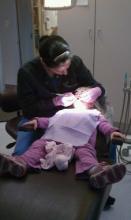When I trained in pediatrics, education about children’s oral health for pediatricians was lacking, especially for children under age 3. At that time it wasn’t common practice to look at the teeth and oral cavity; we looked beyond those structures to the throat, as we assumed the teeth were someone else’s responsibility.
However, data and experience have proven that baby teeth are valuable – and not just as a commodity to be funded by the tooth fairy when extruded! We now know that if children develop early childhood caries (ECC), they are more likely to develop cavities in their adult teeth, leading to pain and suffering, as well as difficulty in school and even in finding a job. Recent trends also show that children as young as 1 or 2 years are requiring general anesthesia for treatment of multiple cavities – procedures that could lead to complications or even death. Primary care providers and dentists need to work together to educate every parent about how to prevent ECC.
 Photo: Courtesy Bryan Reimer
Photo: Courtesy Bryan Reimer
Recent trends show that children as young as 1 or 2 years are requiring general anesthesia for treatment of multiple cavities – procedures that could lead to complications or even death. Primary care providers and dentists need to work together to educate every parent about how to prevent early childhood caries.
In an ideal world, there would be enough pediatric dentists or general dentists who are comfortable seeing kids under age 3 to meet the oral health preventive screening needs. But there are not enough of them, and because pediatricians see children 13 times for well-child visits in the first 3 years of life, it makes sense for us to assess for oral health risk factors and provide anticipatory guidance to families about diet, fluoride, and good oral hygiene. It also makes sense for us to advise the establishment of a dental home for all children starting at age 1. After the age of 3, if a child has been able to establish a dental home, he or she may actually see the dentist more often than the pediatrician and can receive oral health care in the dental setting.
The percentage of pediatricians incorporating oral health risk assessment into the well-child visit is increasing, but it is still not universal. Older pediatricians who have been doing well-child care visits for decades without it may not be eager to add something new. Payment is also an issue, but over the past 3 years the American Academy of Pediatrics (AAP), with funding from the Pew Charitable Trusts, has been able to advocate for payment from Medicaid in 44 states for pediatricians and other primary care medical providers to provide caries prevention services. The AAP continues to advocate for payment in the remaining states and from commercial medical and/or dental insurers.
On the policy front, several efforts have been underway. The AAP established the Section on Oral Health in 1999. Initially, the section was composed of only pediatric dentists, but now pediatricians are welcomed and encouraged to join. Many also are taking an active role in education and policy development. The group has authored two policy statements on oral health in the journal Pediatrics, and has several other policy statements in progress. Current policies include "Preventive Oral Health Intervention for Pediatricians," published in 2008 (Pediatrics 2008:122;1387-94), and "Oral Health Risk Assessment Timing and Establishment of a Dental Home," published in 2003 and reaffirmed in 2009 (Pediatrics 2003:111;1113-6).
In 2006, the AAP chose oral health as one of its strategic initiatives for children, and in 2008, hosted the National Summit on Childrens Oral Health, as well as Pediatrics for the 21st Century (PEDS 21), a symposium held during the AAP’s National Conference and Exhibition, focused on oral health with more than 700 pediatricians in attendance.
In 2009, the AAP received a grant from the American Dental Association Foundation to train pediatricians about oral health. Three annual 2-day meetings were held at AAP headquarters to train an identified oral health "champion" from the majority of AAP Chapters. The goal was for these Chapter Oral Health Advocates to return home and train pediatricians and others about the importance of oral health. They also have advocated at the local and state levels for children’s oral health issues.
Oral health is further solidified as a top child health issue with its inclusion in the "Bright Futures Guidelines for Health Supervision for Infants, Children, and Adolescents," 3rd ed., 2008, as one of the 10 key areas for health supervision. The Affordable Care Act also recommends that preventive care visits for children include Bright Futures recommendations. The AAP/Bright Futures Oral Health Risk Assessment Tool and Tutorial was developed in 2011, following field testing in practices around the country. Recently, it was sent to more than 20,000 practicing pediatricians for use in their practices.


